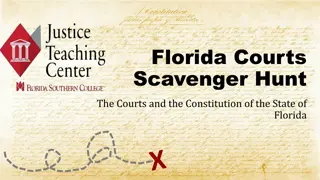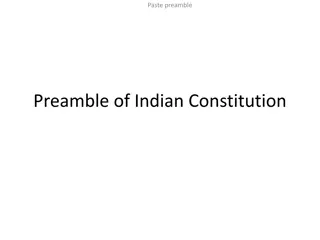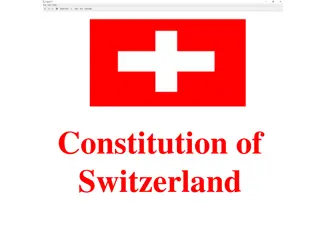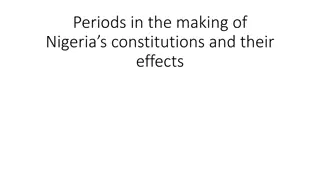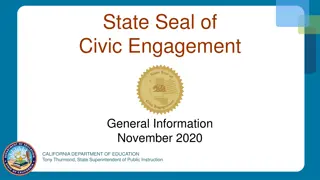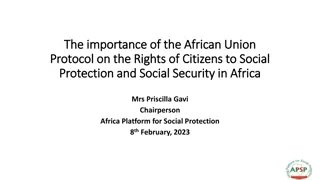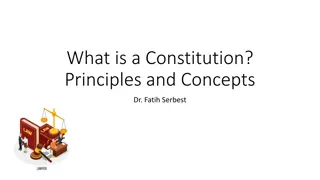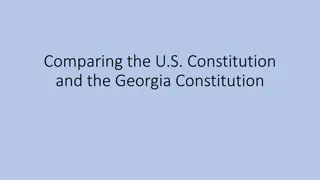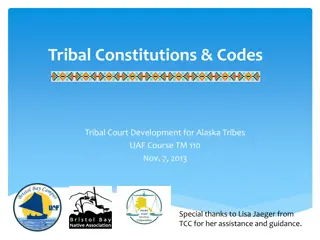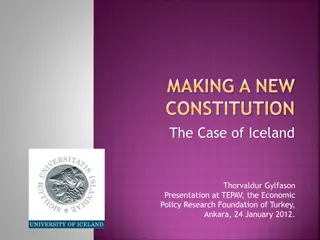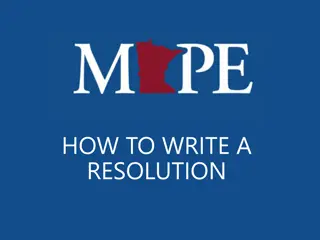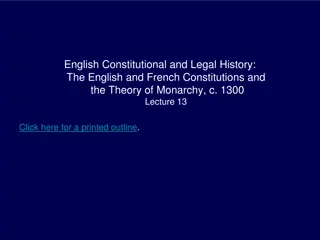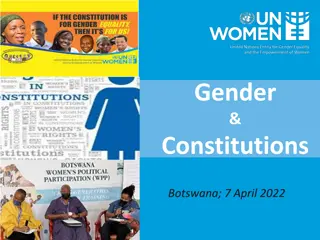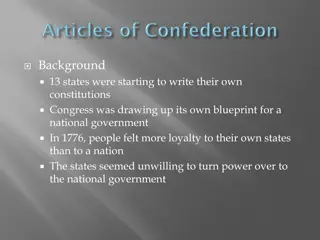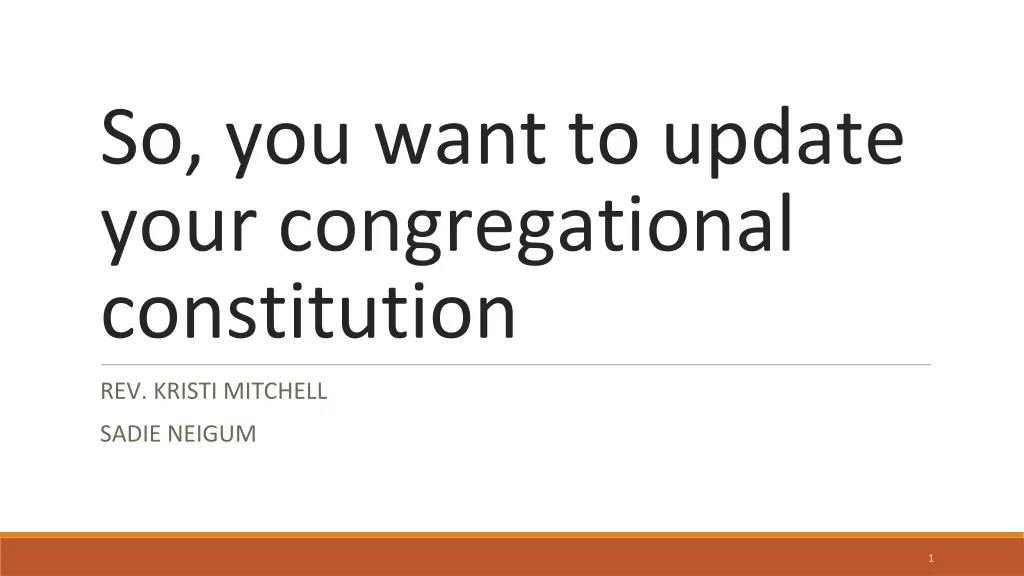
Updating Congregational Constitution: Review Process & Details
Learn how to update your congregational constitution efficiently with a detailed review process. Discover the steps involved, from forming a team to creating a timeline and making proposed changes. Follow the guidelines to ensure a smooth transition in managing difficult situations.
Download Presentation

Please find below an Image/Link to download the presentation.
The content on the website is provided AS IS for your information and personal use only. It may not be sold, licensed, or shared on other websites without obtaining consent from the author. If you encounter any issues during the download, it is possible that the publisher has removed the file from their server.
You are allowed to download the files provided on this website for personal or commercial use, subject to the condition that they are used lawfully. All files are the property of their respective owners.
The content on the website is provided AS IS for your information and personal use only. It may not be sold, licensed, or shared on other websites without obtaining consent from the author.
E N D
Presentation Transcript
So, you want to update your congregational constitution REV. KRISTI MITCHELL SADIE NEIGUM 1
Well, you say, want is not quite right. Need to or ought to are better choices. SE MINNESOTA SYNOD COUNCILS AS LEADERS 8 March 2025 2
Why Constitutions are documents that tell members and interested parties how the congregation will conduct itself. Constitutions are especially helpful when difficult situations arise. It is of great value to have decided on a plan about how to manage such situations when specific emotions factors were not present. The required sections of the Model Constitution have been thoroughly reviewed by individuals with pastoral, legal and human relations expertise. That review is a significant benefit to congregations. You are not giving up autonomy as a congregation or your property by following the Model Constitution. 3
Broad overview of the review process 1) Meet with a synod support team member. This can be done by a phone call or Zoom/FaceTime or even in person if needed. 2) Review your constitution and the ELCA Model Constitution for Congregations of the ELCA. It is available on the ELCA s website. 3) Make proposed changes. 4) Remember that all proposals must be in writing and filed with your congregational council 60 days before formal consideration by your congregation at its annual or special meeting. The council will review the proposals, perhaps make changes and will develop recommendations to forward to the church membership. 5) The congregation council must notify the congregation members at least 30 days in advance of the annual or special meeting. 6) Have the congregational meeting and vote. 7) Forward a copy of the approved constitution with amendments to the synod office. 4
Details of the process (1) Form a team. The process of amending a constitution requires thoughtful work. Locate your current congregational constitution, bylaws and continuing resolutions. Obtain a copy of your congregation s Articles of Incorporation. If you can t find it, a copy can be obtained from the Secretary of State through the Minnesota Department of State s website. In some cases, congregations were incorporated through their county. You can get your Articles there. Download the August 2022 version of the ELCA Model Constitution for Congregations from https://www.elca.org/About/Churchwide/Office-of-the-Secretary/Constitutions . Under Congregations click 2022 Model Constitution. It may be easier to reach it through the SE Mn Synod s website: https://semnsynod.org/resources-for-congregations-and-leaders/constitutions. There is an introduction as part of the downloaded Model Constitution and it should be reviewed. It contains information about: Required and recommended provisions Review by the synod Codification explanation Additional considerations 5
Details of the process (2) Create a timeline. The process will take longer than you expect it to take. Six months is not unusual. A timeline with deadlines will keep you organized and on target for completion. Note the time restrictions on getting the material to the congregation council and the congregation. Ask committees to review their portions of the constitution. Inform them of the timeline and set deadlines. The review team will begin with a clean copy of the Model Constitution (8/2022). Any section that is marked with an asterisk (*) is a required section. It must be included in your congregation s constitution and it must be included as is it cannot be changed in any way. Make any changes deemed appropriate to the non-required (non-*) items in your constitution. Some groups have found it helpful to start with the Model Constitution using it as the foundational document and then adding the other non-required sections to it including all such sections from your current constitution. Alternatively, you can start with your current constitution and add the required (*) sections from the Model Constitution to it. 6
Details of the process (3) Develop a system of marking the changes, such as underlines, strikethroughs or font color changes. This will be very helpful to you, the congregation council and congregation members as the changes are being reviewed. Bylaws and continuing resolutions are to be incorporated into the constitution and are no longer advised to be separate documents. Policies are easily changed and should not be incorporated into the constitution. Once you have a draft constitution ready, send an electronic copy to your synod support team member. The intent of this step is to save you time in the long run, so that changes can be made before the document is sent to your congregation council. Remember the 60-day and 30-day requirements mentioned in the Overview slide. 7
Details of the process, ratification (4) The congregation meets and votes. Once the congregation approves the revised constitution it is then sent to the synod, specifically to Sadie Neigum (neigum@semnsynod.org). She will prepare your constitution for presentation to the synod council. The synod council reviews, approves or disapproves the changes at a regularly scheduled meeting. The synod office will notify the congregation of its decision. The changes go in effect in your congregation upon notification that the synod has approved the revised constitution. 8
*Chapter 16. (1) *C16. provides for two review processes and may be a bit confusing. *C16.01. *C16.02. and *C16.03. refer to sections of the congregational constitutions that are not required by the Model Constitution (viz., the non-* sections) and may be amended by the process described in the slides above. *C16.04. describes situations when the congregation constitution is only being amended to bring any section(s) required or non-required into conformity with section(s) of the Model Constitution that was most recently amended by the Churchwide Assembly, 8/2022 in this case. Conformity is defined as being identical to the wording in the Model Constitution. The congregation council will submit such amendments with their recommendations to the congregation by mail or electronic means at least 30 days before an annual or special meeting. 9
Chapter 16. (2) Once approved by the congregation, the congregation s secretary submits a copy to the synod. Such provisions become effective immediately following the congregation s vote of approval. The synod council is not required to review these changes but may do so at its discretion. 10
Whats the numbering system? (1) C refers to the provision s being part of the constitution. *C means that it is a required provision. Non-required provisions lack the *. The first number is the chapter number. E.g., C5. refers to constitution chapter 5. Notice the period after the number 5 that is used to separate numbers. The next numbers refer to the paragraph within the chapter. E.g., *C5.02. refers to the required paragraph of chapter 5 (powers of the congregation) number 02 concerning the powers invested in the congregational meeting. The next set of numbers are the bylaws. E.g., C10.01.01. is about the congregation meeting (chapter 10) that meets annually (C10.01.) and the bylaw that states the meeting will be in January or February (C10.01.01.) Of note, the Model Constitution has no required or recommended bylaws. 11
What is the numbering system ? (2) Number the continuing resolutions is a bit different. The first two sets of numbers are the same as described above C10.01. that indicates the chapter and paragraph within the chapter. The third set of numbers is preceded by a capital letter indicating sequence and a two-digit number indicating the year of its adoption. E.g., C10.01.A19. would be the first continuing resolution and it would have been adopted in 2019. The second CR would be .B19. The first CR in 2020 would be .A20. CRs are intended to provide more detailed descriptions of operational patterns and practices within the congregation. They should be incorporated following the constitutional provision and/or bylaws to which they apply. Again, the Model Constitution has no suggested or required continuing resolutions. In the Model Constitution you will see that certain numbers are missing from the numbering sequence. These omissions are intentional in order to provide options for future additions. 12


